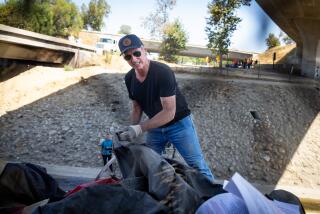Editorial: In the midst of California’s housing crisis, construction slows and lawmakers stall
At a time when California desperately needs to be building a lot more housing to ease the statewide shortage that is driving up prices and fueling homelessness, the pace of residential construction is going down instead of up.
Even as Sacramento and local governments began taking small steps to make it easier to build, permits for new housing fell 16% over the last year. That may not sound like a dramatic drop, but the slowdown is bad news for a state that already has a serious housing deficit. California should be building about 180,000 units per year to keep up with demand, state officials have said, but construction permits for only about 93,000 residential units were issued over the last 12 months, according to the Public Policy Institute of California.
Real estate development is cyclical and there are boom and bust periods. But many Californians seem to think the state is already overdeveloped and that a slowdown would be preferable to an increase. Yet the truth is that residential construction has never returned to levels seen before the Great Recession, despite the state’s strong economy and job market. That has exacerbated an existing shortage created by a decades-long failure to build enough housing to keep up with population growth.
The result? Growing housing inequality and a sense that California’s best days are in the past. The state has the nation’s highest poverty rate when housing costs are factored in. The lack of affordable housing units is driving an epidemic of homelessness. Even many people who don’t become homeless often cannot afford to live in urban areas, and have to move to far-flung suburbs and commute hours to where the jobs are, worsening traffic and air pollution.
On the campaign trail, Gov. Gavin Newsom said he wanted the state to build 3.5 million homes by 2025 to end the housing shortage. At the current pace, it’s hard to imagine that California will come close to that goal. At least, not without major changes to the state’s housing policies. And so far, state and local lawmakers don’t seem to have the political will for major change.
To appease legislators, Newsom had to water down a proposal to withhold transportation dollars from cities that have shirked their responsibility to build enough housing to meet their needs. Some local elected officials in Southern California are fighting efforts to get them zoned for more apartments and affordable housing.
And earlier this year, state legislators put on hold a proposal by Sen. Scott Wiener (D-San Francisco) that would have overridden local zoning laws to allow mid-rise apartment buildings to be constructed within half a mile of major transit stops or in “jobs-rich” areas, including single-family neighborhoods that are now off limits to such development. Opponents in the Legislature said it went too far and they decried the loss of local control, yet they did not put forth a compelling alternative that would help build a lot more housing near transit and job centers.
To be sure, there are lots of reasons for the construction slowdown, only some of which local and state policymakers can control. There is a shortage of construction workers, driven in part by the crackdown on immigration. It’s also gotten more pricey for builders to buy construction materials as cities have had to rebuild after floods and wildfires and after President Trump slapped tariffs on wood and steel. Builders and lenders are also being more cautious amid fears that a recession is looming.
But in many cases, local elected officials are the ones who decide whether new homes get built or not, and far too often, they say “no.” California has to reduce the barriers to building if the state is ever going to end its housing shortage.
More to Read
A cure for the common opinion
Get thought-provoking perspectives with our weekly newsletter.
You may occasionally receive promotional content from the Los Angeles Times.










